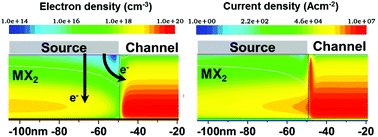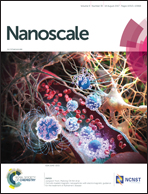From the metal to the channel: a study of carrier injection through the metal/2D MoS2 interface†
Abstract
Despite the fact that two-dimensional MoS2 films continue to be of interest for novel device concepts and beyond silicon technologies, there is still a lack of understanding on the carrier injection at metal/MoS2 interface and effective mitigation of the contact resistance. In this work, we develop a semi-classical model to identify the main mechanisms and trajectories for carrier injection at MoS2 contacts. The proposed model successfully captures the experimentally observed contact behavior and the overall electrical behavior of MoS2 field effect transistors. Using this model, we evaluate the injection trajectories for different MoS2 thicknesses and bias conditions. We find for multilayer (>2) MoS2, the contribution of injection at the contact edge and injection under the contact increase with lateral and perpendicular fields, respectively. Furthermore, we identify that the carriers are predominantly injected at the edge of the contact metal for monolayer and bilayer MoS2. Following these insights, we have found that the transmission line model could significantly overestimate the transfer length and hence the contact resistivity for monolayer and bilayer MoS2. Finally, we evaluate different contact strategies to improve the contact resistance considering the limiting injection trajectory.



 Please wait while we load your content...
Please wait while we load your content...